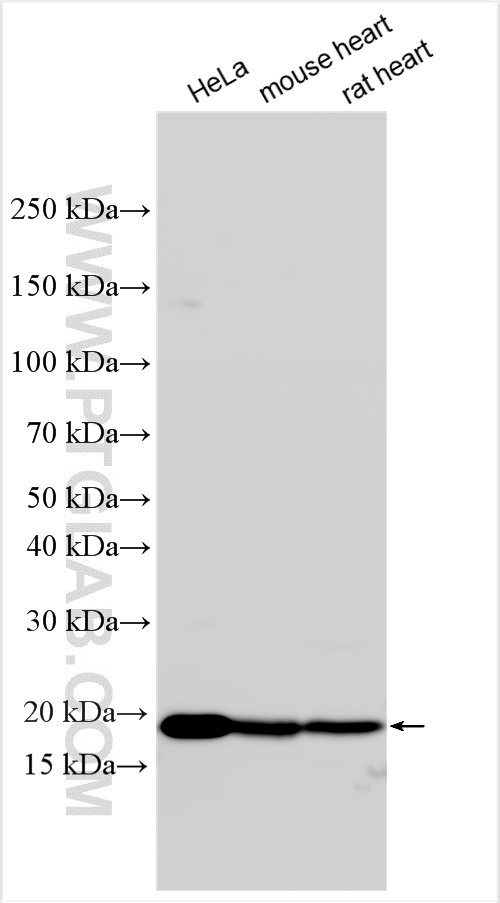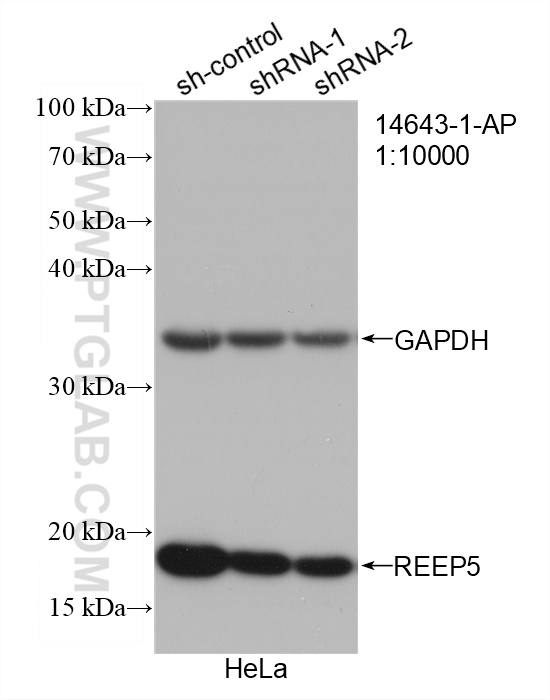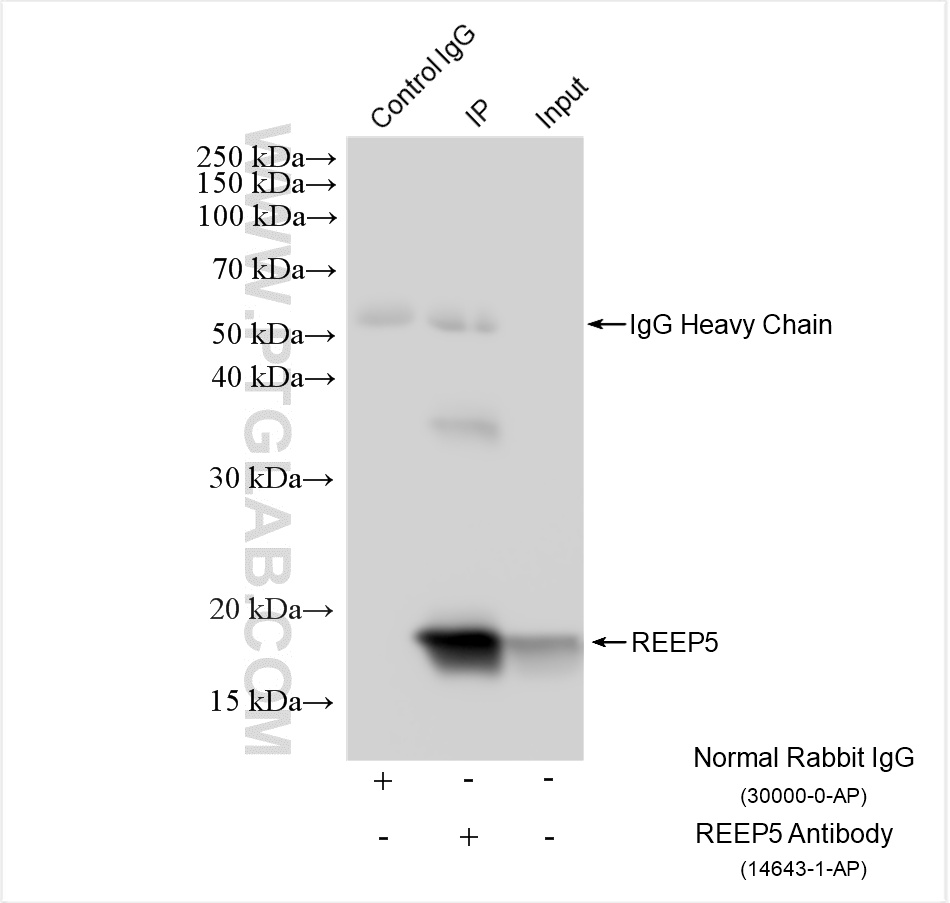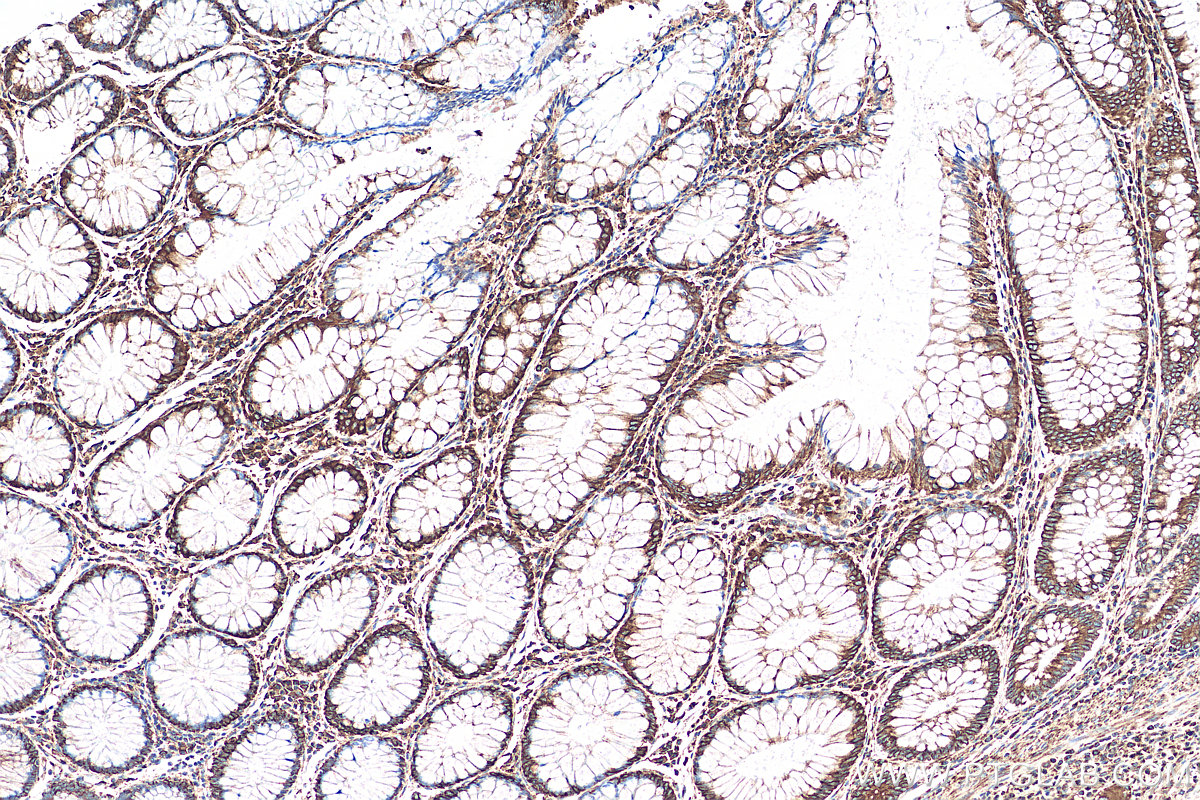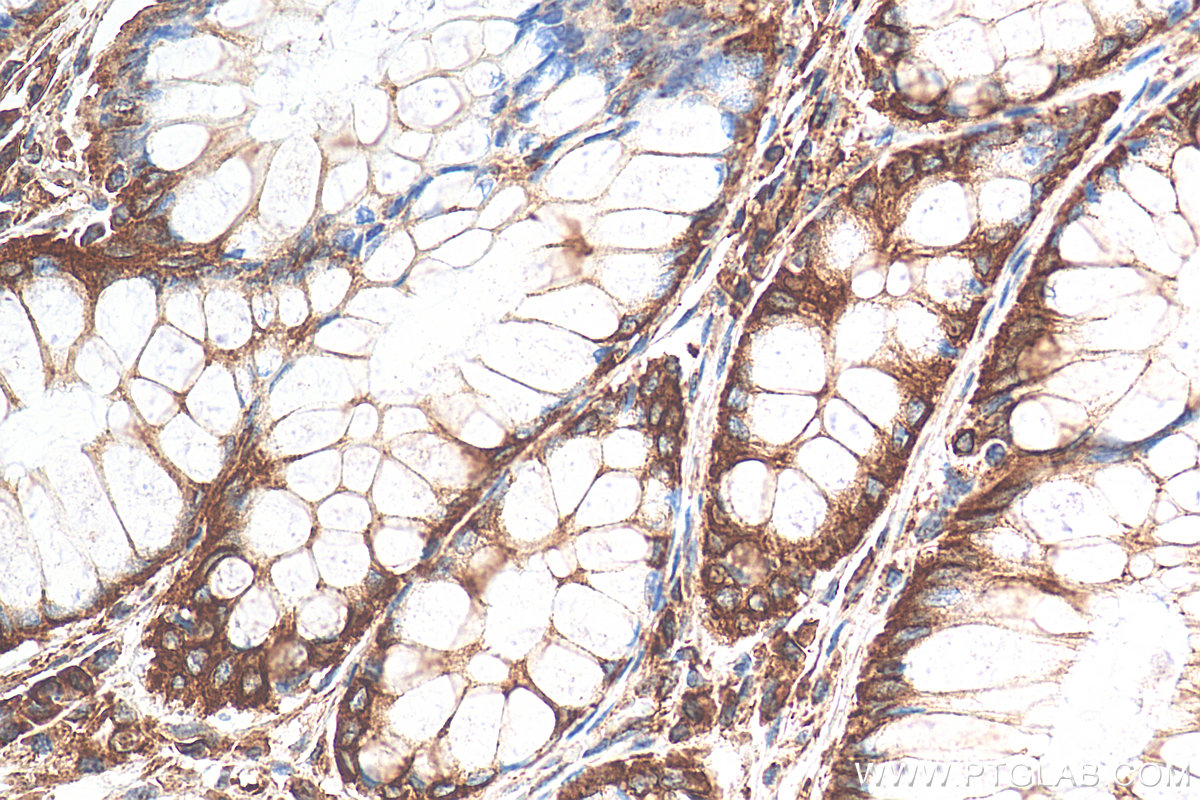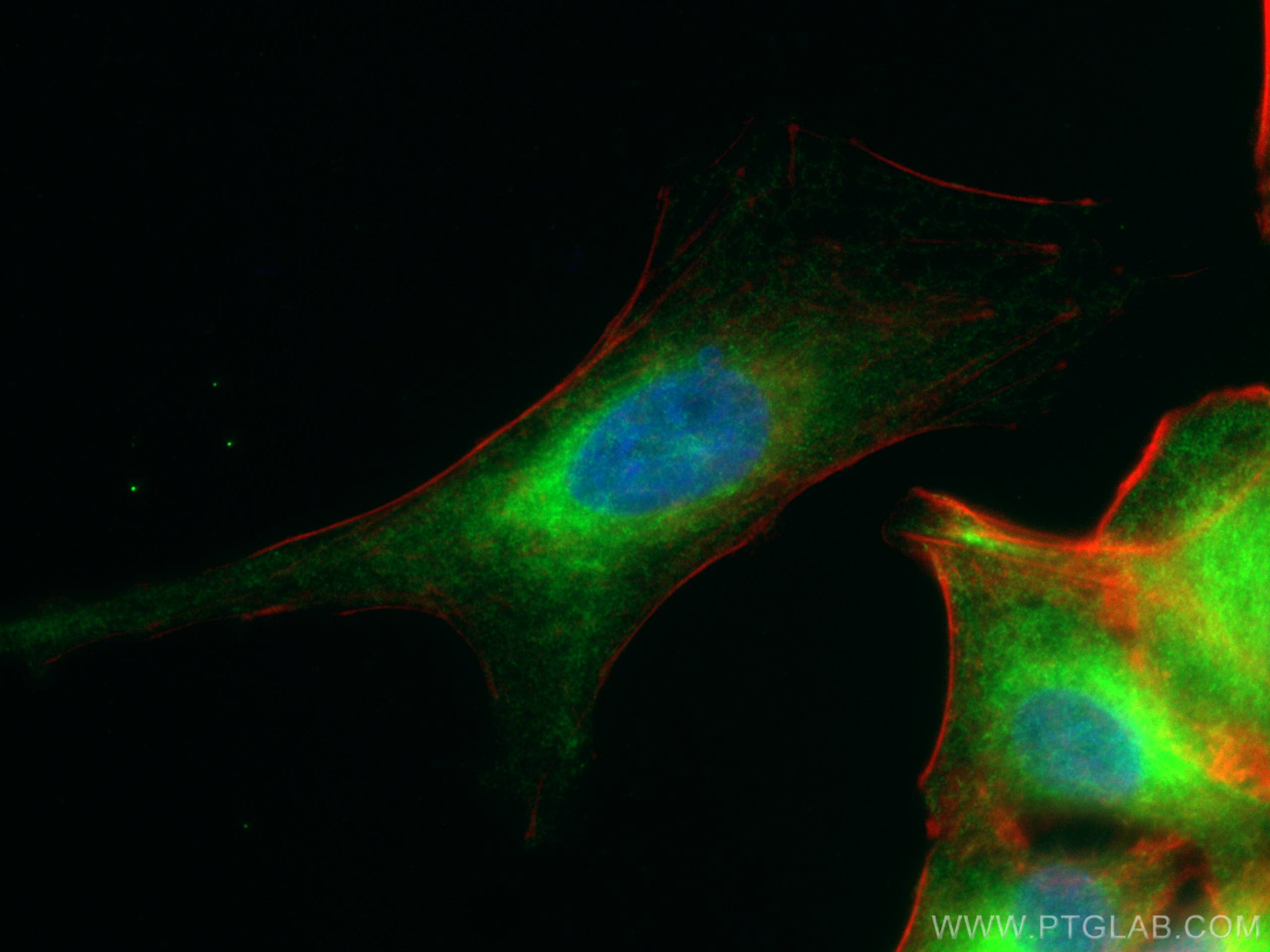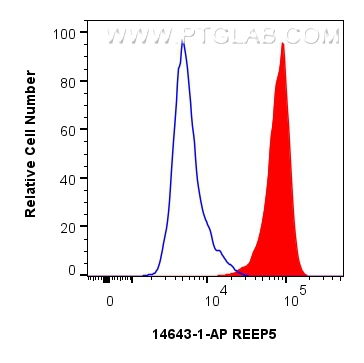验证数据展示
经过测试的应用
| Positive WB detected in | HeLa cells, mouse heart tissue, rat heart tissue |
| Positive IP detected in | HeLa cells |
| Positive IHC detected in | human colon cancer tissue Note: suggested antigen retrieval with TE buffer pH 9.0; (*) Alternatively, antigen retrieval may be performed with citrate buffer pH 6.0 |
| Positive IF/ICC detected in | A549 cells |
| Positive FC (Intra) detected in | HeLa cells |
推荐稀释比
| 应用 | 推荐稀释比 |
|---|---|
| Western Blot (WB) | WB : 1:5000-1:50000 |
| Immunoprecipitation (IP) | IP : 0.5-4.0 ug for 1.0-3.0 mg of total protein lysate |
| Immunohistochemistry (IHC) | IHC : 1:300-1:1200 |
| Immunofluorescence (IF)/ICC | IF/ICC : 1:50-1:500 |
| Flow Cytometry (FC) (INTRA) | FC (INTRA) : 0.25 ug per 10^6 cells in a 100 µl suspension |
| It is recommended that this reagent should be titrated in each testing system to obtain optimal results. | |
| Sample-dependent, Check data in validation data gallery. | |
产品信息
14643-1-AP targets REEP5 in WB, IHC, IF/ICC, FC (Intra), IP, ELISA applications and shows reactivity with human, mouse, rat samples.
| 经测试应用 | WB, IHC, IF/ICC, FC (Intra), IP, ELISA Application Description |
| 文献引用应用 | WB, IHC, IF, IP |
| 经测试反应性 | human, mouse, rat |
| 文献引用反应性 | human, mouse, monkey, xenopus |
| 免疫原 |
CatNo: Ag6229 Product name: Recombinant human REEP5 protein Source: e coli.-derived, PET28a Tag: 6*His Domain: 1-189 aa of BC065926 Sequence: MSAAMRERFDRFLHEKNCMTDLLAKLEAKTGVNRSFIALGVIGLVALYLVFGYGASLLCNLIGFGYPAYISIKAIESPNKEDDTQWLTYWVVYGVFSIAEFFSDIFLSWFPFYYMLKCGFLLWCMAPSPSNGAELLYKRIIRPFFLKHESQMDSVVKDLKDKAKETADAITKEAKKATVNLLGEEKKST 种属同源性预测 |
| 宿主/亚型 | Rabbit / IgG |
| 抗体类别 | Polyclonal |
| 产品类型 | Antibody |
| 全称 | receptor accessory protein 5 |
| 别名 | C5orf18, DP1, Polyposis locus protein 1, Protein TB2, Receptor expression-enhancing protein 5 |
| 计算分子量 | 21 kDa |
| 观测分子量 | 18-21 kDa |
| GenBank蛋白编号 | BC065926 |
| 基因名称 | REEP5 |
| Gene ID (NCBI) | 7905 |
| RRID | AB_2178440 |
| 偶联类型 | Unconjugated |
| 形式 | Liquid |
| 纯化方式 | Antigen affinity purification |
| UNIPROT ID | Q00765 |
| 储存缓冲液 | PBS with 0.02% sodium azide and 50% glycerol, pH 7.3. |
| 储存条件 | Store at -20°C. Stable for one year after shipment. Aliquoting is unnecessary for -20oC storage. |
背景介绍
REEP5 (receptor expression-enhancing protein 5), also named as C5orf18, DP1 or TB2, is a membrane protein belonging to DP1/Yop1p protein family. All REEP proteins contain a conserved TB2/DP1, HVA22 domain which is involved in intracellular trafficking and secretion (PMID: 19123125). REEP5 is expressed in circumvallate papillae and testis, and may have the function to influence functional cell surface expression of taste receptors (PMID: 16720576). REEP5 can interact with atlastins (ATL1 and ATL2) which are involved in modulating the structure of ER network (PMID: 19665976).
实验方案
| Product Specific Protocols | |
|---|---|
| IF protocol for REEP5 antibody 14643-1-AP | Download protocol |
| IHC protocol for REEP5 antibody 14643-1-AP | Download protocol |
| IP protocol for REEP5 antibody 14643-1-AP | Download protocol |
| WB protocol for REEP5 antibody 14643-1-AP | Download protocol |
| Standard Protocols | |
|---|---|
| Click here to view our Standard Protocols |
发表文章
| Species | Application | Title |
|---|---|---|
Cell A Genome-wide ER-phagy Screen Highlights Key Roles of Mitochondrial Metabolism and ER-Resident UFMylation.
| ||
Cell Metab Receptor-Mediated ER Export of Lipoproteins Controls Lipid Homeostasis in Mice and Humans. | ||
Nat Struct Mol Biol Aurora kinase A-mediated phosphorylation triggers structural alteration of Rab1A to enhance ER complexity during mitosis | ||
Nat Commun AMFR-mediated Flavivirus NS2A ubiquitination subverts ER-phagy to augment viral pathogenicity |

